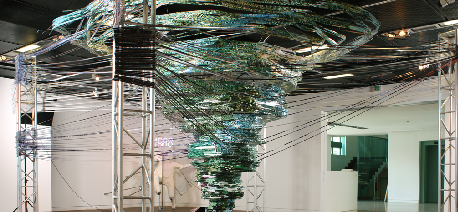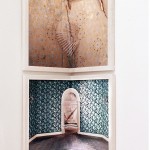Dopo il boom nelle case d’asta nel 2007 le forme d’arte contemporanee coreane bussano vigorosamente alle porte del mondo internazionale. Sofisticate ed impeccabili produzioni d’avanguardia vengono proposte sia in casa alla biennale Media City Seoul, sia l’estero, con le presenze alla Biennale di Venezia ed a Documenta (13). Solo a Londra le manifestazioni sono numerosissime: appuntamenti annuali sono 4482 SASAPARI e il Korean Film Festival al ICA, a cui si sono aggiunti quest’anno la conferenza al Courtauld Between Tradition, Modernity And Globalisation e il festival All Eyes on Korea.

Won Seoungwon, "Dreamroom", 2003. C-prin, 70x100
Tanto interesse per questa piccolissima penisola, perché? Togliendo le ovvie ragioni economiche, l’arte coreana oltre la dicotomia tra tradizione-modernità e nazionale-transnazionale, iniziata con il regime militare degli anni ’60, presenta anche un nuovo spirito. Radicato nelle prime difficili esperienze europee e statunitensi di artisti come Yiso Bahe (Stallabrass, J. and Lee. J., 2012), e fedele alla filosofia del ‘Yuhakseng’ (coreani che si internazionalizzano formandosi all’estero) quest’arte apre nuovi orizzonti, parametri ed immaginari fondendo culture e diverse visioni del mondo.
Un modo per esplorare questa incredibile realtà è The Korean Artist Project (KAP), sito che, organizzato dall’Associazione e i Musei Coreani in collaborazione con i musei privati coreani, è dedicato ai maggiori artisti della penisola offrendo mostre virtuali, video, news e apparati critici.
Qui potrete riscoprire artisti già affermati come Chang Kyum Kim (1961) e Yongbaek Lee (1966), presente alla Biennale di Venezia. Troverete anche opere di artisti meno celebri sulla scena internazionale come le poetiche creazioni di Juyeon Kim (1964) e le fantastiche visioni fotografiche di Myungkeun Koh (1964). Un mondo in cui regnano le nuove tecnologie, utilizzate per reinterpretare con rinnovato vigore e vitalità, tematiche ricorrenti nella storia dell’arte occidentale, come la dicotomia tra illusione, mimesi e realtà.

Siyon Jin, "Flow 3-12, 2012. Oil on canvas, 72.7x116.8 cm.
Riallaciandosi a una lunga tradizione che vede l’uso degli specchi come mezzo per indagare la realtà, Broken Mirror (2011) di Yongbaek Lee, come Pistoletto, assorbe lo spettatore e lo rende allo stesso tempo oggetto e soggetto della rappresentazione. Il silenzioso riflesso però viene interrotto dal rumore improvviso di uno sparo che virtualmente rompe lo specchio. Lo spettatore, diviso tra realtà, riflesso e l’ illusione dello specchio che si rompe, vive un momentaneo disorientamento. Non è solo un virtuosismo di effetti speciali. Radici nella body-art, l’opera è una manipolazione tecnologica e illusionistica di sensazioni corporee, un’ emanazione dell’interazione percettiva e della centralità dell’esserci che è fondamentale in molti lavori della video arte (Bordini, 1995).

Youngmin Kang, "Tornado in Seoul", 2011. Digital prints installation, 300 x 500 x 500 cm.
Similmente Chang Kyum Kim esamina il falso come reale e il reale come falso. Le radici di questa pratica iniziano con le sue nature morte dove ostentatamente dichiara il suo legame con Morandi. Il debito con il maestro bolognese non è solo nel soggetto rappresentato, ma è soprattutto nella materia nostalgica che tanto impregna le sue nature morte. Queste memorie sospese nel tempo, che Kim chiama ‘le memorie dell’assenza’, nelle successive video-installazioni sembrano acquisire solida forma. Kim crea quest’illusione di ‘realtá’ proiettando su calchi bianchi di oggetti immagini di oggetti. Al termine della proiezione, però, esse si dissolvono svelando la loro natura d’ombra, sono solo fantasmi di altre esistenze come nella video-installazione Letter (2000). L’artista qui si rappresenta mentre scrive una lettera al suo sè di 20 anni prima. Kim si chiede, nel suo monologo dolce che accompagna il video, “eri (l’artista del passato) realmente là? ed io (l’artista del presente) ero anch’io realmente là?” cosa è più reale? l’immagine, memoria viva nei nostri intelletti o l’oggetto fisico inanimato? Come sostiene Choonghwan GOH (2011), critico d’arte coreano, che lega le opere di Kim alla filosofia Taoista di Zhangzise, se non c’è un ‘io’ dal passato non c’è nessun ‘io’ presente che possa trovare la sua essenza nel passato. Non c’è nessuna prova fisica del ‘io’. Kim usando le moving images in modo moderatamente statico amplifica la nostra comprensione sul significato delle immagini conducendoci alla soglia tra allucinazione e auto consapevolezza e ponendoci domande sull’esistenza dell’uomo.
Queste opere come le altre presentate dal KAP sono testimoni di come la Corea sia all’avanguardia sul sondaggio estetico, concettuale e spirituale del linguaggio video, dando concretezza ciò che non si vede e non si tocca. Apriamo quindi le porte agli effetti speciali e lasciamoci scivolare nella densità emotiva che ci dona.
Livia Dubon
Riferimenti bibliografici
- Stallabrass, J. and Lee J. (2012) Between Tradition, Modernity And Globalisation. Available at:http://www.courtauld.ac.uk/researchforum/events/2012/summer/jun29_KoreanArtConf.shtml (Accessed: 27/11/2012).
- Bordini, S. (1995) Video Arte & Arte, tracce per una storia. Roma: Lithos
.
- Choonghwan GOH (2011) ‘Get Lost Between Reality and Image’. Korean Artist Project, [Online]. Available at: http://www.koreanartistproject.com/eng_artist.art?method=artistView&auth_reg_no=32 (Accessed: 26/11/2012).
:: ::
After the market explosion of 2007 Korean contemporary art is, without a doubt, vigorously knocking at the door of international success. Sophisticated and impeccable art productions are being offered both domestically, in Media City Seoul, and overseas at the Biennale of Venice and Documenta (13). London offers more and more events each year. 4482 SASAPARI and the Korean Film Festival at the ICA are some of the annual happenings. This year also saw Between Tradition, Modernity and Globalisation, a conference at the Courtauld, and the festival All Eyes on Korea.
Why so much interest in this small peninsula? Excluding obvious economical reasons, Korean art represents a new spirit beyond the dichotomy between tradition/modernity and national/transnational, inherited from the military regime of 1960s. Rooted in the early destitutions of artists such as Yiso Bahe in Europe and U.S.A (Stallabrass, J. and Lee. J., 2012), as well as in the spirit of the ‘Yuhakseng’ (Korean student oversees), this type of art opens up new horizons, dimensions and imagery, blending different cultures and visions of the world.
A useful gateway to this incredible world is the Korean Artist Project (KAP) website, organized by the Korean Museum Association in collaboration with the Korean Private Museums. KAP offers virtual exhibitions, videos, news and reviews allowing the user to learn more about leading Korean artists such as Chang Kyum Kim (1961) and Yongbaek Lee (1966).Also, it displays works by less renowned artists, such as the profound and poetic art of Juyeon Kim (1964) and the incredible photographic visions of Myungkeun Koh (1964). New technologies are on the rise in this area, giving a renewed vigour and vitality to recurrent themes in western History of Art, such as the dichotomy between illusion, mimesis and reality.
Embedded in the long tradition, where the mirror is a tool to investigate the ‘real’, Broken Mirror (2011) by Yongbaek Lee captures and traps the audience as the mirrors of Pistoletto. People see their reflections, unaware that they have been transformed into the spectacle. They become both the subject and the object of the representation. The silent reflection is disrupted by the sound of a gunshot, which virtually breaks the mirror. The viewer, divided between reality (his/her reflection) and illusion (the broken mirror), can experience a brief moment of disorientation. This is not simply a virtuoso use of special effects. The activation of the work through the viewer’s emotional response, rooted in the body-art, is a technological and illusionistic manipulation of physical feelings. It is an emanation of the perceptive interaction and centrality of the being, which constitute so much of the foundation of most video art (Bordini, 1995).
Similarly Chang Kyum Kim investigates the fake as real, the false as true. The origin of this practice starts with his still lifes, where he unquestionably declares his association with Morandi. The influence of the metaphysic Italian master is not merely formal; it evokes echoes of nostalgia, a distinctive element of his ‘natura morte’. These past memories, frozen in a time frame, which the artist calls ‘the memory of absence’, seem to acquire substantial form. Kim creates this illusion of ‘reality’ by projecting on white casts of objects images of ‘real’ objects. However, when the projection ends, these ‘real’ objects disappear, revealing the shadowy nature of the images – ghostlike traces of other existences, such as in the artwork “Letter” (2000). Here the artist reveals himself while writing a letter to his past self of 20 years ago. He asks, “Were you (the artist in the past) there? Was I (the artist in the present) there?” What is more real; the image, a vivid memory in our intellect or the physical inanimate object? As explained by a Korean art critic, Choonghwan GOH (2011), who relates Kim’s works to Zhangzise’s Taoism: if there is no ‘I’ from the past, there is no present ‘I’, who finds his or her existential root in the past. There is no physical evidence of ‘I’. Through the use of moving images Kim expands the dimension of our thought on images to the extent of the existential question of human being.
These works, like most of the others showcased on KAP, are examples of the Korean aesthetic, conceptual and spiritual research on video art giving concreteness to what is out of the field of vision. Therefore, letting us open our doors to special effects and let us drift into the emotional density that comes with this.
Livia Dubon
References:
- Stallabrass, J. and Lee J. (2012) Between Tradition, Modernity And Globalisation. Available at:http://www.courtauld.ac.uk/researchforum/events/2012/summer/jun29_KoreanArtConf.shtml(Accessed: 27/11/2012)
- Bordini, S. (1995) Video Arte & Arte, tracce per una storia. Roma: Lithos
- Choonghwan GOH (2011) ‘Get Lost Between Reality and Image’. Korean Artist Project, [Online]. Available at:http://www.koreanartistproject.com/eng_artist.art?method=artistView&auth_reg_no=32 (Accessed: 26/11/2012).





SCHEDE